How often do you monitor data relevant to your customer service? Do you know how good your customer service metrics are . . . have you measured them? How well do your teams perform when it comes to customer care – keeping them happy, dealing with complaints, upselling, cross-selling, responding quickly to their enquiries? Are your employees pulling their weight and helping to retain your precious customers? Rafferty Gifford shows how you can track their performance.
Whether they’re shopping online or in-store, the modern consumer expects good service.
By 2020, it is predicted that customer service will beat price and product as the top brand influencer – how exactly are you going to meet these expectations?
Currently, most companies are failing to meet expectations. But, luckily for you, this is the perfect opportunity to make a name for your brand by delivering out-of-this-world customer service.
However, in order to improve, you’ll need to know what’s working and what isn’t – this is where customer service metrics come in.
Now you might be thinking: “I already know how to find my customer metrics”, but the difficultly isn’t necessarily in finding the data. It’s knowing which metrics you should be tracking.
Here are six key customer service metrics you need to be monitoring:
- Overall Satisfaction
Customer satisfaction applies to all aspects of your business – it determines whether your customers are actually happy with you and how they perceive your brand. Naturally, businesses with happy customers continue to grow, while those with continually unhappy customers are likely to fall.
A study by Livework on customer experience found 96% of dissatisfied customers won’t complain, but 91% will never buy from you again, so it’s crucial you’re doing all you can to encourage your customers to give feedback.
Tracking customer service metrics is subjective and doesn’t always give the full picture, so it isn’t as straightforward as monitoring, for example, traffic sources and page response time. However, there are some easy ways around this.
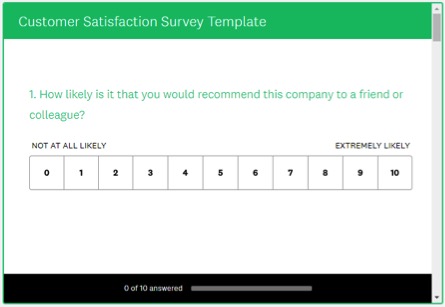
Creating surveys and adding feedback ratings (eg. 1-5 stars) each time a customer makes a purchase is a great way to find out their experience with your business.
Tools such as SurveyMonkey provide a post-service satisfaction survey template, which asks customers to rate their experiences based on the service they have received. You can find and use the template here.
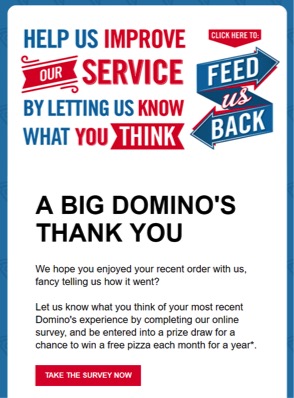
You can also embed these surveys into your email marketing, like Domino’s does (see right), every time a customer places an order.
Once you’ve analysed your customer metrics, you can decide on your next steps. Remember, these metrics aren’t designed to tarnish your business – the only way you can deliver exceptional customer service is by understanding what your customers expect.
If you discover your customers aren’t satisfied, at least you can now start implementing changes based on their feedback. If significant changes are required, then you could apply for a business credit card, using companies such as Liberis to obtain additional funds.
- Customer Retention/Return Customers
The art of finding, targeting and obtaining new customers is often a top priority for most businesses. However, did you know it costs five times as much to attract a new customer than to retain an existing one?
To avoid these high customer acquisition costs, maintaining strong relationships with existing customers should be your business’s first port of call. After all, customers who are already happy with your service are far likelier to stick around.
Your service team is at the heart of customer retention, which is why you need to monitor your customer support metrics from their perspective. Once a sale has been made, the customer’s first point of contact will be your service team.
A rise in customer retention means your team are doing an effective job, whereas a decline could mean they aren’t working hard enough to build these relationships. Listening to recorded phone calls and monitoring digital communication (eg. emails, live chats) is a good way to see if your teams are doing all they can.
Even a small increase in customer retention can improve your overall profitability. Businesses that grow their customer retention rates by as little as 5% typically see profit increases ranging from 25% to 95% (Groove HQ).
- Average Response Time to Complaints
Time is everything for efficient customer service; especially when it comes to resolving an issue. According to iWeb, 34% of customers consider getting their issue resolved quickly to be the most important feature of customer support.
In a customer’s eyes, companies that really care about them have quick response times; especially with the first response. Sending first responses fast also provides immediate relief – you now have time to understand the issue and work out a resolution.
To measure the overall effectiveness of your customer service you’ll need to look into your average time to resolution metric (in other words, how long it takes your team to resolve a complaint).
Take the average response time from all your means of communication (eg. social media, email, phone calls) to determine how you’re performing. Obviously, the faster you can resolve an issue the better. But this shouldn’t mean the quality of the response is sacrificed.
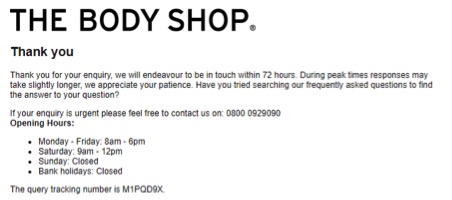
If a complaint is submitted via email, you can send out auto acknowledgements to customers to let them know you’ve received their request and when they can expect a response. The Body Shop’s auto acknowledgement emails (see left) also helpfully includes its opening hours, so customers aren’t waiting for a response when they’re closed.
- Employee Productivity
No matter how fantastic your customer service is, you can’t eliminate all complaints. But if you want issues to be resolved in a timely manner and to keep your customers happy, employees need to be pulling their weight.
Every business uses different gauges to measure employee productivity. One way you can measure productivity is by knowing the average number of customer enquiries you get daily, weekly and monthly. Armed with this information you can develop a target number to be resolved within each timeframe which will help to create benchmarks for your service team.
Once you know how many you receive, you can evaluate employee productivity against this metric. If they are under-performing, then you can encourage greater efforts in order to improve the customer satisfaction levels.
- Preferred Communication Channel
The number of channels businesses implement to communicate with their customers has continued to grow; especially in the digital world.
Nowadays, consumers expect immediate answers to their queries and it’s likely they’ll also have a preference for how they’re happiest with contacting a brand and being contacted by the brand. Knowing this is a crucial metric for increasing customer satisfaction.
You can start by looking at the number of customer enquiries you get per channel. Note, this will usually vary from business to business.
For example, expensive purchases (eg. a holiday or employing a solicitor) tend to require more in-depth conversations, meaning customers are likely to revert to the phone. Alternatively, a simple enquiry about when a product will be back in stock could quickly be answered over social media or live chat.
Here are some current insights into consumer’s preferred communication channels:
Social media:
Social media is king. However, it has amplified consumer impatience:
Unfortunately, companies aren’t living up to these expectations:
- For Facebook, the average business response time is 1 day, 3 hours and 7 minutes and for Twitter it is 1 day, 7 hours and 12 minutes (Online Moderation)
Live Chat:
If consumers want immediate answers, then live chat is becoming their default choice:
- 79% of consumers will choose live chat because of the immediacy it offers, while 73% have been left ‘satisfied’ with their live chat experience (Super Office)
Email:
Customers prefer emails for complaints:
- Emails are the top form of communication for making a complaint (eConsultancy)
However, far too many companies aren’t bothering to reply:
- 62% of companies don’t respond to customer service emails
Phone Calls:
Despite the evolution of digital communication, customers will still pick up the phone as a last resort:
- 50% of customers will call if none of the above methods brought the desired result (Nice.com)
If you’ve noticed a clear customer preference, you can invest more resources (eg. employees) into this channel. You might also discover a particular channel has more unanswered queries than others, which you can then discuss with your customer service team.
- Upsell and Cross-sell Frequency
Are your sales teams constantly striving to bring in new customers? Great! But what about encouraging those who are already about to make a purchase?
As we’ve said before, it costs five times as much to bring in a new customers than to retain an existing one, so ensuring your team is striving to sell more to one customer is crucial. Upselling and cross-selling (similar, but very different) are two simple, yet effective ways to do this.
First, it’s important to understand the clear difference between upselling and cross-selling:
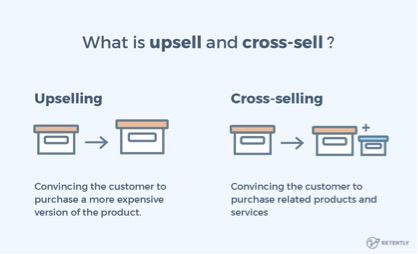
Click the image for details from retently.com
For example, if you offer SaaS (software as a service), then encouraging a customer to upgrade from the basic plan to the premium version would be upselling.
On the other hand, if a customer representative at an electronics retailer suggested that a customer should also buy an SD card alongside their digital camera, this would be cross-selling. Amazon attributes 35% of its revenue to cross-selling.
Now you know the differences, are you going to gauge how successful your employees’ upselling techniques are?
For tracking upselling and cross-selling metrics, be sure to look into the amount of effort your employees are making and whether they are spending the correct amount of time on the right products. One way you can do this is by assigning specific employees to particular products. Then, delve into the costs associated with these employees and apply it to your sales-related customer acquisition cost (CAC) for each product.
Have an opinion on this article? Please join in the discussion: the GMA is a community of data driven marketers and YOUR opinion counts.

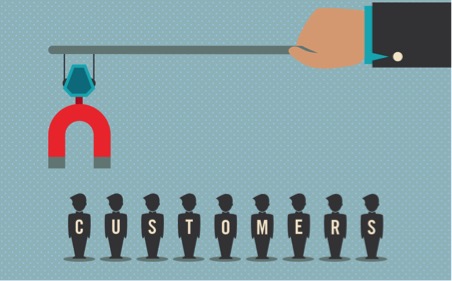







Leave your thoughts